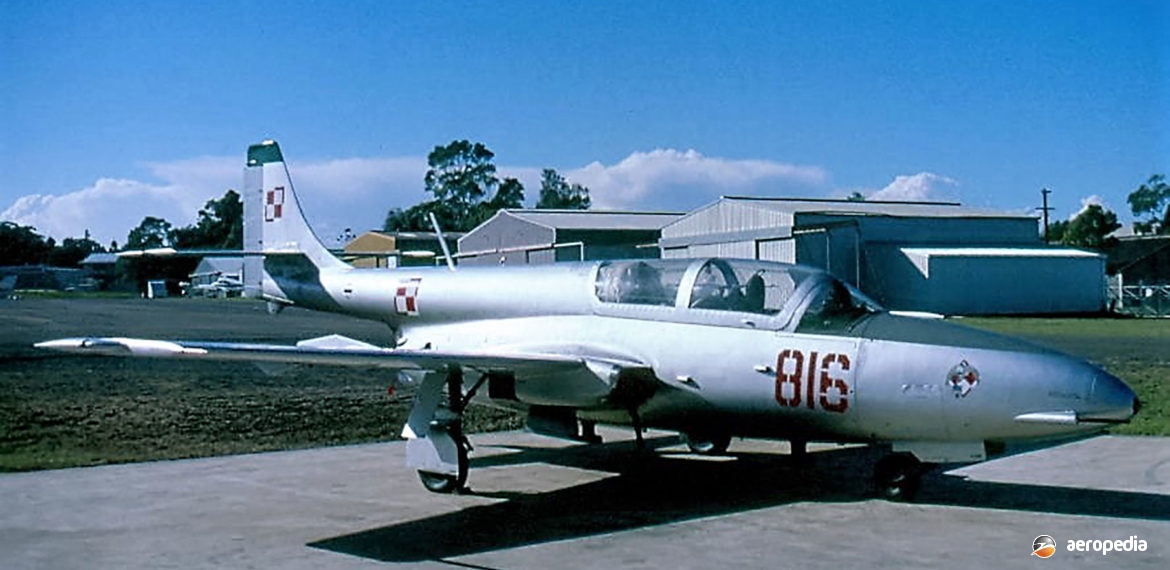Photograph:
PZL TS-11 Iskra VH-ADG (c/n IHO816) at Bankstown, NSW in February 1995 (David C Eyre)
Country of origin:
Poland
Description:
Two-seat military trainer
Power Plant:
One 2,205 lbst PZL-Rzeszow SO-3 single-shaft axial-flow turbojet
Specifications:
- Wingspan: 10.06 m (33 ft)
- Length: 11.15 m (36 ft 5 in)
- Height: 3.5 m (11 ft 5½ in)
- Wing area: 17.5 m² (188.37 sq ft)
- Max speed at 5,000 m (16,405 ft): 720 km/h (447 mph)
- Max cruising speed at 7,000 m (22,965 ft): 600 km/h (373 mph)
- Range cruising speed at 7,000 m (22,965 ft): 490 km/h (304 mph)
- Initial rate of climb: 657 m/min (2,156 ft/min)
- Time to 6,000 m (19,685 ft): 9.6 mins
- Service ceiling: 11,140 m (36,550 ft)
- Range with max fuel: 1,160 km (720 miles)
- Empty weight: 2,494 kg (5,498 lb)
- Loaded weight: 3,810 kg (8,400 lb)
Armament:
One 23 mm NS-23 cannon in starboard forward fuselage; in Iskra Bis D various combinations of ordinance on four underwing pylons
History:
In the late fifties design and development took place in Poland, Czechoslovakia and the USSR of a series of two-seat military trainers powered by turbojet engines to meet a common requirement, the proposal being that the best design of the three (TS-1 Iskra, L-29 Delfin and Yak 30) would be chosen for use by the Soviet Air Force, the Warsaw Pact countries, and perhaps other countries aligned with the Eastern bloc. In the event, the Delfin was chosen as the winner, but the Iskra was built in some numbers in a variety of variants for the Polish Air Force.
Development of the TS-11 Iskra (Spark) took place at the Osrodek Konstrukcji Lotniczych (Aircraft Construction Centre) at Warsaw – Okecie. The second of four prototypes was flown for the first time on 5 February 1960 by Andrzej Ablamowicz, the first prototype being used for static testing; numbers three and four joining the test programme in March and July 1961. Production took place at the Wytwornia Sprzetu Komunikackyjnego facility at Mielec, the first production machine being delivered in March 1963. Early production aircraft were fitted with the 1,700 lbst TO-2 axial-flow turbojet, the intakes being located in the wing roots. Seating was for two in tandem, and lightweight ejection seats were installed. Hydraulic power was used for aileron operation, the elevators and rudder being manually operated. As with most military jet trainers, armament included fixed forward firing guns in the nose, and a selection of bombs, rockets, or fuel tanks on underwing stations.
As production continued, the type was developed and, at various stages, up-rated engines were fitted, including the 1,720 lbst HO-10, and later the SO-2, SO-3, and SO-3W. Progressive models included the bis A, bis B, the 200 series known as the bis C, bis D and a multi-role model known as the bis DF. An export customer was the Indian Air Force, with 50 being delivered in the 1970s to replace de Havilland Vampires with the fighter training wing at the Indian Air Force Air Academy (formerly the Fighter Training Wing) at Hakimpet.
In Poland the type served with the Polish Air Force Academy’s 58th LPSz at Deblin, the 60th LPSz at Radom and the 66th LPSz at Tomaszow Mazowieckie. A number were converted as the TS-11R and, with three cameras installed, operated with the 7th Regiment of the Polish Navy at Siemirowice. Production concluded in 1979 after some 500 had been delivered but resumed in 1982 to produce the Iskra bis DF, which was a dedicated reconnaissance training model.
In April 1992 an Iskra (serial IHO816) arrived in Sydney, NSW subsequently being restored at Bankstown, NSW and becoming VH-ADG in Polish Air Force markings. In all five have appeared on the Australian register with registrations in the VH-IS block and a number of others underwent some restoration work for a period. Those registered included: VH-ISK (c/n IHO608), VH-ISX (c/n IHO701), VH-ISY (c/n IHO705) and VH-ISZ (c/n IHO403). Two others are known to have been imported, c/ns IHO705 and IHO728. The type became popular as a warbird, one batch of 25 arriving at Tulsa, Oklahoma in the United States in 1992 for restoration. VH-ADG is part of the collection of HARS aircraft at Parkes, NSW and is on display in a static condition.
By late 2017 none of the Australian Iskras were known to be airworthy and one of the aircraft imported was loaned to the Ballarat Aviation Museum (serial 717), being placed on display. Most Australian examples have been retired but VH-ISK and VH-ISX, both based in Victoria, still appeared on the Register in late 2019.

